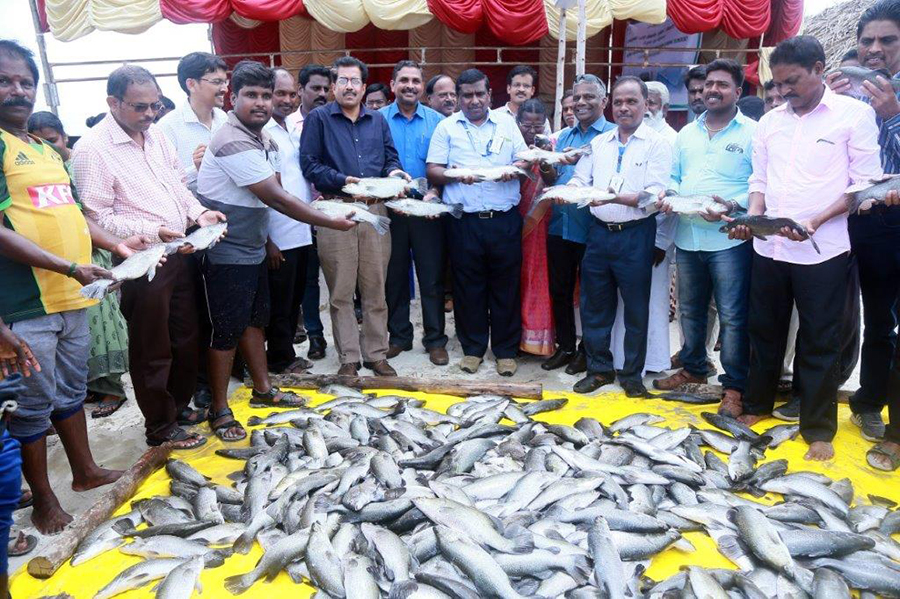Farming of brackishwater fishes in locally crafted cages suitable for estuaries, creeks, backwaters and lagoons is an emerging innovative and viable technology for the production of valuable finfish such as seabass. The technology is efficient in utilizing the vast stretches of brackishwater resources along the costal India for increased fish production, employment creation and income generation, falls under the vision of Indian Govt. under the blue revolution. In this direction, the ICAR-Central Institute of Brackishwater Aquaculture (ICAR-CIBA), Chennai which is the nodal research institution for the development of brackishwater aquaculture in collaboration with the National Institute of Ocean Technology (NIOT), Chennai has successfully demonstrated cage farming of Asian seabass fish (Lates calcarifer) in the Buckingham canal waters at Vennangupattu coastal village in Kancheepuram District of Tamil Nadu. CIBA mobilised the fisher youths from the villages. Skill development training has been provided as part of Attracting and Retaining Youth in Agriculture (ARYA) initiative of ICAR-CIBA partnering with NIOT on cage designing, fabrication, installation, nursery rearing and farming of fishes in cages. Susequently facilitated them to form a self help group which they named as Dr.A.P.J.Abdulkalam Fish Producers Self Help Group, to take up the cage farming in the backwaters in in Kancheepuram district of Tamil Nadu.
A novel three tier model comprising nursery rearing, pre-grow out and grow out cages were taken up in a phased manner. Asian seabass (Lates calcarifer) fish was chosen as culture species due to its growth potential, availability of seed and feed and higher market value. The farming cycle began with stocking of fish fry (1cm size) initially in the nursery cages, they were grown to fingerlings size in 45-60 days (7-8 cm size), transferred from nurseries to pre-grow-out cage and then 90-100g juveniles from pre-grow out were transferred to grow out cages for further rearing. The stocking density adopted was 12 kg per/m3. The fishes were fed with CIBA’s formulated indigenous feed (SeebassPlus @ Rs80/kg)) respectively @ 10-8%, 4-6% and 2-4% of their body weight in nursery, pre-grow-out and grow out stages. The average Feed Conversion Ratio (FCR) realised was 1.85:1(1.85 kg feed to produce 1 kg fish). The juveniles were grown to a marketable size of 900 g – 1.25 kg in 6 months. A productivity of 460 kg was realised in two partial harvests in one cycle. Two cycles of production can be taken in a year. The production cost was worked out to be Rs.190 per kg of fish and sale price was Rs.380 per kg with a B: C ratio of 2.0. The fish producers were linked to Tamil Nadu Fisheries Development Corporation a state government body which procures fishes from producers giving farm gate price and sale to the consumers through its outlets.
A harvest cum interaction meet was organised at the farming site at Vennangupattu village, on 4th August, 2017. About 120 fishers including fisherwomen and school children in the neighbourhood participated in the event and witnessed the harvest. Dr.K.K.Vijayan, Director, ICAR-CIBA handed over the revenue generated from the sale of fish produced to the group during the meeting. He expressed that the three-tier cage farming has proved to be a successful model and opined that the group members can divide themselves in to three units to look after one component each and one unit can sell their produce to the other unit for further rearing so that everyone can get income in 3-4 months. Revenue due to the women members of the group who have reared the fish fry to fingerlings size (stage-1) which is a critical task was handed over to them during the event. Localised designing of cages for the brackishwaters has been done by NIOT team led by Dr.R.Kirubagaran, Head, Marine Biotechnology Division, NIOT, Chennai and coordinator from NIOT side. Fisheries being the state subject, state fisheries department extended the full support and Mrs. Chandra, Joint Director of Fisheries, Tamil Nadu witnessed the harvest was of the view that CIBA has provided a viable technology for the state fisheries department which will be taken up for popularization to other coastal districts of the state. Similarly, Shri.Ajay Anand, Joint Director of Fisheries, Pondicherry Union Territory has informed that their department has already initiated a work plan with CIBA to take up cage farming in the backwaters of Pondicherry Union Territory. This concept adopted a ‘logical technology transfer mode’ starting with skill development, provision of inputs (seed and feed) for once cycle, successful cage rearing and production, successful marketing, can be easily duplicated. This three-tier cage farming model of is a win-win model available for fishers as an alternative livelihood option, and also an employment opportunity for the unemployed youth asserted Dr.M.Kumaran, Principal Scientist and coordinator of the programme.
[Best_Wordpress_Gallery id=”30″ gal_title=”A Success story – 4th Aug 17″]
